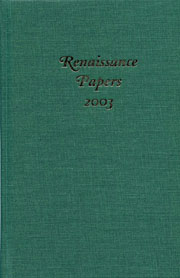Book contents
- Frontmatter
- Contents
- Renaissance Papers
- Homer, Erasmus, and the Problem of Strife
- William Tyndale Among the Demons
- The Printing of “this written book”: G.T. and H.W.'s Editorial Disputes in The Adventures of Master F.J.
- George Puttenham as Comedic Artificer
- Amoret and Scudamour Woo and Wed: Two Courtly Histories and a Stalemate
- Strange Bedfellows: “The Churching of Women” and The Taming of the Shrew
- “Romans, countrymen, and lovers”: Performing Politics, Sovereign Amity and Masculinity in Julius Caesar
- “Rouse Up a Brave Mind”: The Merchant of Venice and Social Uprising in the 1590s
- Revenge Tragedy and Elizabeth Cary's Mariam
- “very worthely sett in printe”: Writing the Virginia Company of London
Amoret and Scudamour Woo and Wed: Two Courtly Histories and a Stalemate
Published online by Cambridge University Press: 12 September 2012
- Frontmatter
- Contents
- Renaissance Papers
- Homer, Erasmus, and the Problem of Strife
- William Tyndale Among the Demons
- The Printing of “this written book”: G.T. and H.W.'s Editorial Disputes in The Adventures of Master F.J.
- George Puttenham as Comedic Artificer
- Amoret and Scudamour Woo and Wed: Two Courtly Histories and a Stalemate
- Strange Bedfellows: “The Churching of Women” and The Taming of the Shrew
- “Romans, countrymen, and lovers”: Performing Politics, Sovereign Amity and Masculinity in Julius Caesar
- “Rouse Up a Brave Mind”: The Merchant of Venice and Social Uprising in the 1590s
- Revenge Tragedy and Elizabeth Cary's Mariam
- “very worthely sett in printe”: Writing the Virginia Company of London
Summary
Just why Amoret ends up in the House of Busirane at the end of Book 3 remains one of the more popular and contested questions that readers of The Faerie Queene attempt to answer. Spenser's narrator, of course, provides a literal narrative answer to the question at the beginning of Book 4, where readers learn that Busirane kidnaps Amoret—oddly, “[b]y way of sport”—during the antimasque portion of the entertainment at her wedding feast; she is “[c]onueyed quite away to liuing wight vnknowen.” But this answer, at least insofar as it suggests a random act of abduction, satisfies attentive readers of Spenser's allegory about as much as saying that Redcrosse abandons Una merely because Archimago tricks him or that Acrasia's victims end up in the Bower of Bliss only because the witch lures them there against their will. Although this kind of unmediated causation usually seems sufficient to satisfy Spenser's narrator, and although mysterious forces of fortune and providence often seem to influence the narrative, the poem draws readers into its allegorical method by inviting them to seek thematically consistent explanations for narrative events. Since Busirane, his house, and his masque represent forces that threaten and seek to control Amoret, exposing her vulnerabilities and testing her strengths, her encounter with Busirane serves to refine and complicate the meaning of her role in Spenser's poem. Conversely, the trajectory of her story, her role in Spenser's allegory of chaste love, her relationship with Scudamour, and, as this essay adds, her own choices motivate and help to explain her abduction and imprisonment.
- Type
- Chapter
- Information
- Renaissance Papers 2003 , pp. 71 - 82Publisher: Boydell & BrewerPrint publication year: 2004



